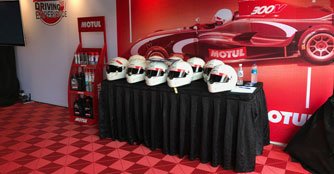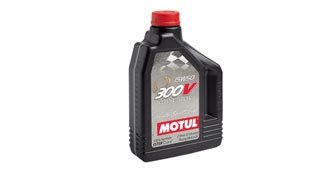Here's what you'll need to drive a Formula 4 race car
01 Aug 2017|24,844 views
The pandemonium of screeching tyres, a rumbling sound from a race car, voices of excitement filling the air: These are familiar sounds from the Sepang International Circuit that greet the ears of many participants at the Motul Driving Experience 2017. Initial visual impressions, too, will spark recognition in anyone who has seen a Formula One race car, whether live at the event around Marina Bay Street Circuit or on the television.
Closer inspection, though, reveals a particular pulse-racing notion that illustrates two defiantly Formula 4 race cars sitting quietly at the pit lane with two engineers and two mechanics in their Motul uniforms surrounding them.
I head upstairs to the paddock area to get dressed - a set of blood red race suit and a pair of shoes to match. Minutes, which felt like hours, passed and I finally walked towards one of the single-seater race cars while holding on to my balaclava and gloves on my left and my helmet on my right.
"You'll get about eight laps in this thing," a lady in another Motul uniform told me. Everything was starting to become a blur. I was getting drenched in my sweat, and the heat was starting to get to my head and vision.
I hopped in, listened to a myriad of instructions on how to get the race car started and off I went. The first... second... third lap. Then I realised I wasn't exactly prepared for this. There are at least five basic requirements you'll need to man-handle the Formula 4 race car and I didn't meet them all.

Regardless whether or not the sun is out blazing its heat on you or it's hiding behind dark clouds with rain splattering down on your race shoes, you're still going to sweat like a dog with his tongue out panting away in a thick and cumbersome racing suit.
But that's what racing suits are made for. They're not created to keep you warm but to ensure its fireproof qualities keep you from getting burnt during a race should your car catch fire.
As such, always hydrate yourself with ample water. Don't find it troublesome if you need to go to the toilet to relieve yourself. Trust me, it's worth it. Repeat this process as many times as you can before you go for your race.

In other words, try to remain as calm as possible.
As lame and childish as this may sound, composing your nerves and excitement when you're all dressed up for the occasion isn't exactly a walk in the park. With all the tyres screeching, exhaust notes screaming and people around you getting excited, you'll find yourself fighting hard trying to keep your blood pressure down.
A nurse, who was there to take everyone's blood pressure readings, advised me on a couple of things. Firstly, go somewhere quiet and breathe normally. Secondly, stop the caffeine intake, which means no coffee or tea. Lastly, start sipping on water at a leisurely pace. 20 minutes later after heeding her advice, my blood pressure readings went from 180/40 to 120/80.

You'll have to try and understand one thing. The Formula 4 isn't a regular car with an electric or hydraulic power steering. It's a 1.6-litre race car with a five-speed sequential gearbox that has no power steering whatsoever.
While you will definitely be able to handle an 80kg professional race kart with no power-assisted steering and still go bonkers in it, it's a lot tougher with a 160bhp race car like this that weighs some 470kg. Going round corners at 150km/h is going to require some strength and muscle work.
Hence, stretch those arms as much as you can before hopping into a Formula 4 race car.
4. Check what engine oil the race car is using
While you may think this is unnecessary, think again. Using an unsuitable engine oil on a Formula 4 car will lead to high wear and tear of moving parts, high engine oil consumption as well as unstable oil pressure throughout a race.
On our race car, eight and a half litres of Motul 300V Competition 15W50 was used to safely tackle high engine oil dilution by unburned fuel, providing optimum engine protection.
Engine oils with viscosities of 15W50 and 20W60 are commonly used in races because they're more stable than the regular ones like a Motul H-Tech 100 Plus 5W30. In simpler terms, the closer these numbers are to each other, the more stable an engine oil becomes.
5. Ensure your seating position is right
This was something I realised I didn't quite get right. Given my 'short and sweet' fun-sized body height, several rubber mats had to be placed behind me to ensure that my legs could reach the pedals, especially the clutch.
But the enthusiasm and excitement got the better of me, and I told one of the guys to stop with the mats the moment I could clutch in.
The problem was I wasn't close enough to the steering wheel, which meant every sharp turn that I had to make on the track required a lot more muscle work than I should be using. This tired me out very quickly, and my arms and shoulders started to ache after the fifth lap, and I still had another three more to go!
The pandemonium of screeching tyres, a rumbling sound from a race car, voices of excitement filling the air: These are familiar sounds from the Sepang International Circuit that greet the ears of many participants at the Motul Driving Experience 2017. Initial visual impressions, too, will spark recognition in anyone who has seen a Formula One race car, whether live at the event around Marina Bay Street Circuit or on the television.
Closer inspection, though, reveals a particular pulse-racing notion that illustrates two defiantly Formula 4 race cars sitting quietly at the pit lane with two engineers and two mechanics in their Motul uniforms surrounding them.
I head upstairs to the paddock area to get dressed - a set of blood red race suit and a pair of shoes to match. Minutes, which felt like hours, passed and I finally walked towards one of the single-seater race cars while holding on to my balaclava and gloves on my left and my helmet on my right.
"You'll get about eight laps in this thing," a lady in another Motul uniform told me. Everything was starting to become a blur. I was getting drenched in my sweat, and the heat was starting to get to my head and vision.
I hopped in, listened to a myriad of instructions on how to get the race car started and off I went. The first... second... third lap. Then I realised I wasn't exactly prepared for this. There are at least five basic requirements you'll need to man-handle the Formula 4 race car and I didn't meet them all.

1. Hydrate, release and rehydrate
Regardless whether or not the sun is out blazing its heat on you or it's hiding behind dark clouds with rain splattering down on your race shoes, you're still going to sweat like a dog with his tongue out panting away in a thick and cumbersome racing suit.
But that's what racing suits are made for. They're not created to keep you warm but to ensure its fireproof qualities keep you from getting burnt during a race should your car catch fire.
As such, always hydrate yourself with ample water. Don't find it troublesome if you need to go to the toilet to relieve yourself. Trust me, it's worth it. Repeat this process as many times as you can before you go for your race.

2. Don't let the excitement get to you
In other words, try to remain as calm as possible.
As lame and childish as this may sound, composing your nerves and excitement when you're all dressed up for the occasion isn't exactly a walk in the park. With all the tyres screeching, exhaust notes screaming and people around you getting excited, you'll find yourself fighting hard trying to keep your blood pressure down.
A nurse, who was there to take everyone's blood pressure readings, advised me on a couple of things. Firstly, go somewhere quiet and breathe normally. Secondly, stop the caffeine intake, which means no coffee or tea. Lastly, start sipping on water at a leisurely pace. 20 minutes later after heeding her advice, my blood pressure readings went from 180/40 to 120/80.

3. Stretch those arms
You'll have to try and understand one thing. The Formula 4 isn't a regular car with an electric or hydraulic power steering. It's a 1.6-litre race car with a five-speed sequential gearbox that has no power steering whatsoever.
While you will definitely be able to handle an 80kg professional race kart with no power-assisted steering and still go bonkers in it, it's a lot tougher with a 160bhp race car like this that weighs some 470kg. Going round corners at 150km/h is going to require some strength and muscle work.
Hence, stretch those arms as much as you can before hopping into a Formula 4 race car.
4. Check what engine oil the race car is using
While you may think this is unnecessary, think again. Using an unsuitable engine oil on a Formula 4 car will lead to high wear and tear of moving parts, high engine oil consumption as well as unstable oil pressure throughout a race.
On our race car, eight and a half litres of Motul 300V Competition 15W50 was used to safely tackle high engine oil dilution by unburned fuel, providing optimum engine protection.
Engine oils with viscosities of 15W50 and 20W60 are commonly used in races because they're more stable than the regular ones like a Motul H-Tech 100 Plus 5W30. In simpler terms, the closer these numbers are to each other, the more stable an engine oil becomes.
5. Ensure your seating position is right
This was something I realised I didn't quite get right. Given my 'short and sweet' fun-sized body height, several rubber mats had to be placed behind me to ensure that my legs could reach the pedals, especially the clutch.
But the enthusiasm and excitement got the better of me, and I told one of the guys to stop with the mats the moment I could clutch in.
The problem was I wasn't close enough to the steering wheel, which meant every sharp turn that I had to make on the track required a lot more muscle work than I should be using. This tired me out very quickly, and my arms and shoulders started to ache after the fifth lap, and I still had another three more to go!
Thank You For Your Subscription.



























